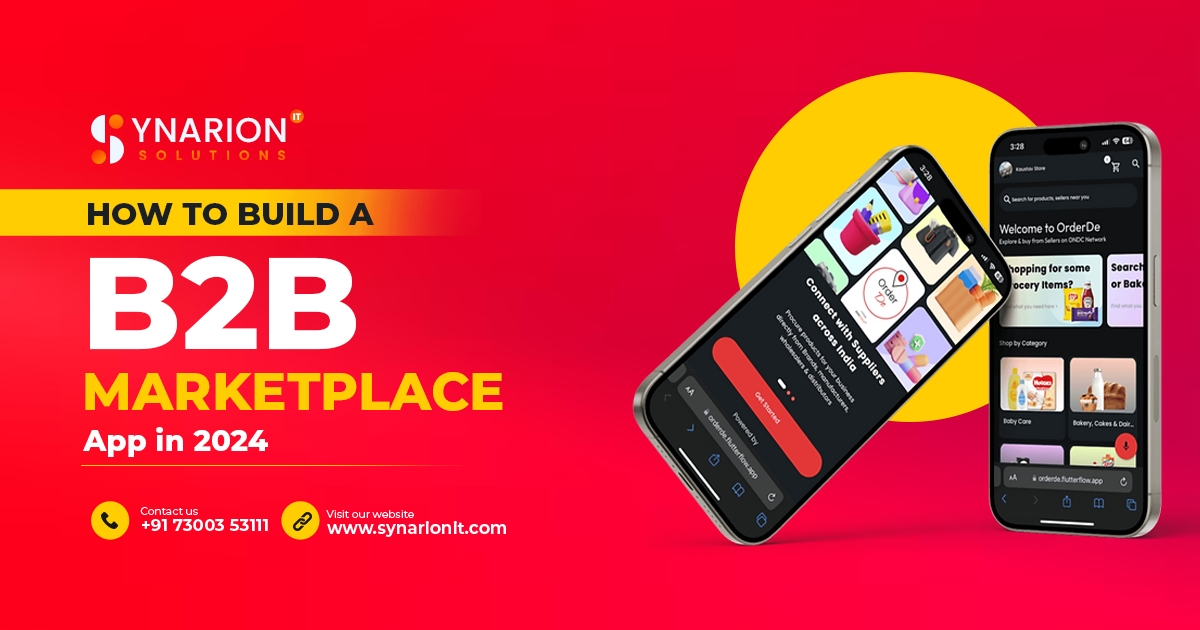Read our ultimate guide to find the right ways to create a marketplace app from scratch.
The global business-to-business (B2B) e-commerce market, valued at approximately USD 18,665.95 billion in 2023, is poised for substantial growth, with a projected compound annual growth rate (CAGR) of 18.2% from 2024 to 2030. This surge is driven by rapid technological advancements, including artificial intelligence (AI), machine learning (ML), and data analytics. As businesses increasingly leverage these innovations to enhance their operations, the demand for sophisticated B2B marketplace app is rising.
This guide delves into the essentials of developing a B2B marketplace app from scratch, providing insights into the critical technological components and strategies necessary to build a successful platform in this dynamic market.
What is the B2B Marketplace? Explanation in Simple Words
A B2B (Business-to-Business) marketplace is an online platform where businesses buy and sell products or services to each other. In 2024, the digital age has transformed the way businesses operate, with more companies preferring online transactions due to convenience and wider reach. Traditional offline markets have limitations, while digital platforms offer a more efficient way for businesses to connect, trade, and grow. A B2B marketplace uses technology to make it easier for buyers and sellers to meet their needs, providing a space where transactions happen quickly and seamlessly, driving business growth.
Easy Steps to Create a B2B Marketplace App from Scratch
Research & Planning
Begin by analyzing market trends, competitors, and customer needs. Understand your target audience and define the core features for your B2B marketplace app. A well-researched plan will guide you in creating an efficient and user-friendly platform.
Choose a Business Model
Select the right business model for your B2B marketplace, such as commission-based, subscription-based, or freemium. This decision impacts how you generate revenue, attract users, and scale the platform in the long run.
Define Key Features
Identify essential features like user registration, product listings, search functionality, secure payment gateways, and communication tools. Consider additional features like AI-based product recommendations and analytics to enhance user experience and optimize business operations.
Select the Right Technology Stack
Choose a reliable tech stack that supports scalability, security, and performance. Common options include programming languages (JavaScript, Python), databases (MySQL, MongoDB), and cloud services (AWS, Google Cloud) to ensure a robust backend and smooth app performance.
Design User Interface (UI) & User Experience (UX)
Create a user-friendly interface that simplifies navigation and offers an intuitive experience. Focus on clear layouts, fast-loading pages, and mobile optimization to ensure users can easily browse, purchase, and interact on your platform.
Develop the Backend
Set up a secure and scalable backend for data management, user authentication, and real-time communication. Use APIs to integrate third-party services like payment gateways, and ensure seamless synchronization between the front-end and backend.
Integrate Payment Systems
Incorporate multiple payment gateways that support secure, real-time transactions for various currencies. Ensure compatibility with popular payment methods like credit cards, digital wallets, and bank transfers to accommodate global B2B transactions.
Test & Debug
Conduct extensive testing to identify bugs, security issues, and performance glitches. Use different devices and environments to ensure the app is fully functional and meets industry standards before launching it to the public.
Launch & Market the App
Launch your app on major app stores and promote it through digital marketing channels, such as SEO, social media, and paid ads. Utilize email campaigns and partnerships to attract early users and build momentum.
Monitor & Improve
After launch, continuously monitor user feedback, app performance, and security issues. Implement regular updates and improvements to enhance features, fix bugs, and ensure your platform remains competitive in the evolving B2B marketplace industry.
Top 6 B2B Marketplace Apps Generating Million-Dollar Revenue
- Alibaba
- eWordTrade
- Amazon Business
- AliExpress
- Global Sources
- IndiaMART
Closing Lines: B2B Marketplace App Development in 2024
In 2024, the B2B marketplace continues to thrive, driven by advancements in digital technology. This blog covers essential topics, starting with a simple explanation of what a B2B marketplace is and its role in the digital economy. We’ve also outlined the easy steps to B2B Marketplace App Development from scratch, offering guidance on research, technology, and features. Lastly, we highlighted the top 6 B2B marketplace apps generating million-dollar revenues, including Alibaba, eWorldTrade, and Amazon Business. As businesses increasingly embrace digital solutions, creating a robust B2B marketplace app presents a tremendous growth opportunity.



Pingback:10 Secrets for a Successful Medicine Delivery App Development